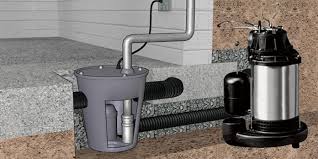A sump pump is a pump used to remove water that has accumulated in a water-collecting sump basin, commonly found in the basements of homes. The water may enter via the perimeter drains of a basement waterproofing system, funnelling into a collection point or SUMP.
Sump pumps are typically used where basement flooding happens regularly and to solve dampness where the water table is above the foundation of a home. Sump pumps send water away from a house to any place where it is no longer problematic, such as a municipal stormwater drain or a storage dam if the water is to be recovered.
There are generally two types of sump pumps, pedestal, and submersible. In the case of the pedestal pump, the motor is mounted above the sump, where it is more easily serviced, but is also more conspicuous. The pump impeller is driven by a long, vertical extension shaft and the impeller is in a scroll housing in the base of the pump. The submersible pump, on the other hand, is entirely mounted inside the sump and is specially sealed to prevent electrical short circuits. There is a debate about which variety of sump pump is better. Pedestal sump pumps usually last longer if they are installed properly and kept free of debris but tend to not be suitable for residential installations. Submersible pumps are the more popular option. They can take up debris without clogging and are much less obtrusive.
Sump pump systems are also utilised in industrial and commercial applications to control water table-related problems in surface soil. An artesian aquifer or periodic high water table situation can cause the ground to become unstable due to water saturation. As long as the pump functions, the surface soil will remain stable. These sumps are typically 3m (10 feet) in depth or more, lined with a corrugated metal pipe that contains perforations or drain holes throughout. They may include electronic control systems with visual and audible alarms and are usually covered to prevent debris and animals from falling in.

Sump pumps must be maintained. Typical recommendations suggest examining equipment every year. Pumps running frequently due to higher water tables, water drainage, or weather conditions should be examined more frequently. Sump pumps, being mechanical devices, will fail eventually, which could lead to a flooded basement and costly repairs. Redundancy in the system (multiple/secondary pumps) can help to avoid problems when maintenance and repairs are needed on the primary system.
When examining a sump pump and cleaning it, dirt, gravel, sand and other debris should be removed to increase efficiency and extend the life of the pump. These obstructions can also decrease the pumps ability to drain the sump and can allow the sump to overflow. The check valve can also jam from the debris. Examine the discharge line opening, when applicable, to ensure there are no obstructions in the line. Even a partially obstructed discharge line can force a sump pump to work harder and increase its chance of overheating and failure.

